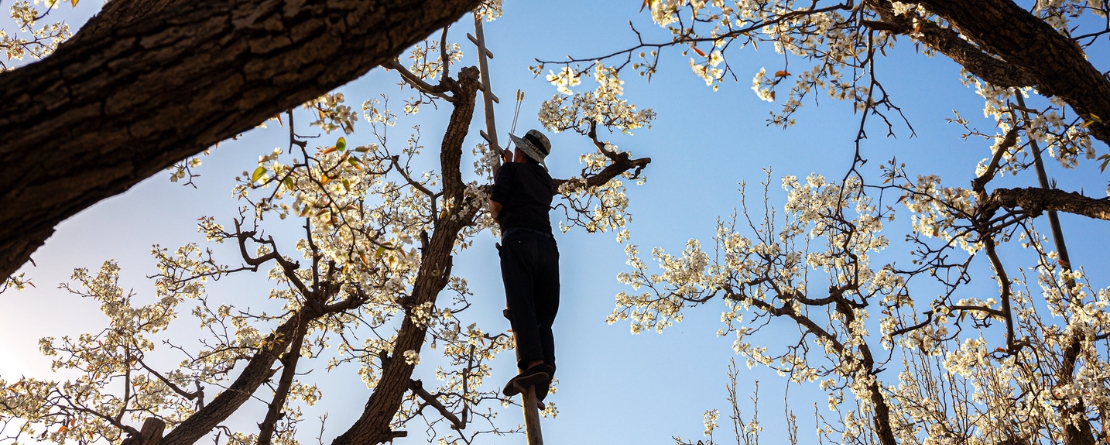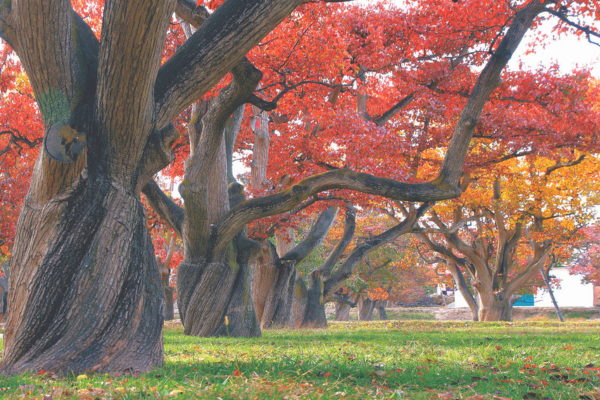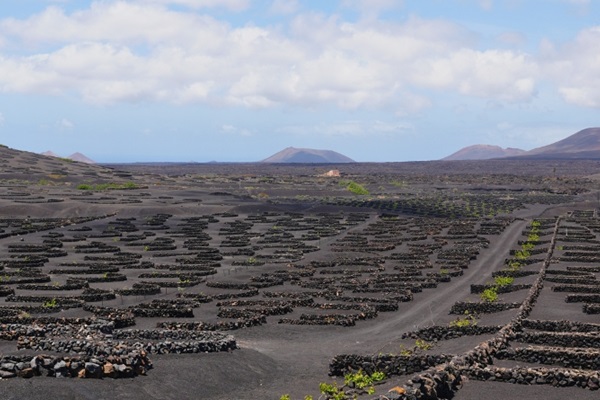Gaolan Shichuan Ancient Pear Orchard System in Gansu Province, China
GIAHS since 2025

©GIAHS/Gaolan Shichuan Ancient Pear Orchard System in Gansu
In Shichuan, a 600-year-old agroforestry system thrives along the Yellow River, where towering pear trees are cultivated using the traditional “Gaotian” method. Integrating fruit trees, crops, and livestock, it preserves ancient varieties like Ruan’er and Dongguo. Resilient to droughts and floods, the system sustains agrobiodiversity, food security, and rural livelihoods, reflecting harmony between tradition and ecology.
Global importance
The site holds global significance as a genetic center of origin for Chinese pear cultivation, with continuous large-scale production since 1522. It conserves over 9,400 ancient pear trees older than 100 years, making it one of the richest repositories of pear germplasm and traditional agricultural knowledge. The tall, deep-rooted trees exhibit remarkable resilience to both floods and droughts, thriving around homes, fields, and hilly terrain. Their sustained productivity and ecological roles—such as stabilizing soil, retaining water, and creating microclimates—make them essential to the landscape and local livelihoods. The agroforestry system also supports a diversity of crops, livestock, and soil biodiversity, forming a resilient and sustainable farming model adapted to the Yellow River Basin. Low-density planting and integrated practices contribute to food security, generate income, and support environmental integrity, while also aiding in the conservation of endangered species.
Food and livelihood security
This proposed GIAHS site showcases impressive agricultural diversity that contributes significantly to food security and sustainable livelihoods. Anchored in the cultivation of high-quality Dongguo and Ruan’er pears, the system also produces various value-added goods, such as frozen pears, pear syrup, and dried pears, which are used in both traditional medicine and local cuisine. A complete value chain has developed around pear cultivation, processing, and agro-tourism, enhancing income opportunities and generating jobs. These products are widely distributed across Lanzhou and other regions in China, bringing substantial economic benefits. In particular, the Ruan’er pear—also known as the Xiangshui pear—is central to the production of frozen pears in northwest China.
The multifunctional nature of the system has helped increase the annual per capita disposable income in the area by 15,000 yuan and has diversified employment for local residents. Beyond pear cultivation, farmers practice agroforestry by growing grains, legumes, vegetables, and medicinal herbs, and by raising dairy goats, poultry, and ducks. This integrated approach supports a balanced and nutritious diet for the community, reinforcing the system’s role as a vital source of food and livelihoods.
Agrobiodiversity
This GIAHS site is a key reservoir of ancient pear germplasm and agricultural biodiversity, preserving over 20 cultivated pear varieties, with Dongguo and Ruan’er being the most prominent. In addition, the site supports nearly 20 other cultivated crops—including grains, legumes, vegetables, medicinal herbs, and green manure species—alongside a diverse array of over 20 species of weeds and insects.
Traditional farming practices play a central role in conserving biodiversity beyond cultivated species. The landscape serves as a habitat, migration corridor, and refuge for a variety of wildlife, including protected species such as the blue sheep. The ancient orchards, in particular, provide vital foraging grounds and shelters for animals in the surrounding hilly desert grasslands. These time-honored practices not only sustain agricultural productivity but also uphold the broader ecological integrity of the region.
Local and traditional knowledge systems
The site is a living repository of traditional farming knowledge, particularly in the cultivation of ancient pear trees through a technique known as “Gaotian” or “fields in the sky.” This method, refined over centuries, involves the use of scaling ladders in a practice called “Tianbashi,” allowing farmers to manage pear trees that grow over ten meters tall. Activities such as pruning, pollination, fruit thinning, harvesting, and nature-based pest control—including the use of tobacco fermentation broth or mud on tree trunks—are all conducted according to traditional seasonal calendars.
The site follows a low-density planting model—around 150 trees per hectare—which improves light and airflow and facilitates intercropping. This is complemented by traditional courtyard-based agroforestry systems that integrate pear trees with grains, vegetables, medicinal herbs, and livestock such as goats, chickens, and ducks. These practices not only enhance productivity but also strengthen community identity and support agro-tourism.
Ecologically, the site demonstrates a nature-positive and sustainable farming system. The deep root systems of the ancient trees improve soil structure and nutrient cycling, gradually enhancing the fertility of sandy soils and enabling productive intercropping. Farmers use seasonal crop rotation and traditional storage and processing methods, reinforcing local food security and resilience. The knowledge developed in these orchards has been adapted and applied in newer plantations and surrounding landscapes—from hilly grasslands to the Yellow River valley—creating a coherent, ecologically sound agroforestry system aligned with the values of the GIAHS programme.
Culture, value Systems, and social organization
Traditional agricultural knowledge at this heritage site is closely interwoven with cultural and spiritual practices, forming a vibrant socio-cultural landscape centered on festivals, rituals, and community life. Celebrations such as “Shehuo” (Folk Fire), held during the Spring Festival, reflect deep-rooted beliefs tied to farming and seasonal cycles. These include lantern displays, “Tiexinzi” performances, and the Lanzhou Taiping Drum, all rooted in the worship of the earth and fire gods. The handmade Shichuan lanterns, recognized in 2017 as provincial intangible cultural heritage, exemplify the region’s artisanal heritage.
Cultural continuity is also evident in ancestor worship during the Qingming Festival and the Pear Blossom Festival. Longstanding families, such as the Wei and Tao lineages, lead ceremonies in which the best fruits are offered to ancestors. Rituals often incorporate elements of intangible heritage such as Shehuo performances and Taiping drum music, reinforcing moral values and social cohesion. Culinary traditions add another layer to this cultural fabric, with local specialties like frozen Ruan’er pears—known as “China’s oldest ice cream”—and heated Dongguo pears (Redongguo) representing both edible heritage and sensory memory.
Community institutions, such as the Ancient Pear Orchard Conservation Center, manage conservation, education, and research initiatives, while fostering a shared identity among farmers. Museums and local preservation efforts further demonstrate a collective commitment to safeguarding the system, which remains essential to cultural identity, ecological harmony, and rural development.
Landscape features
The heritage landscape is a distinctive ecological and cultural mosaic shaped by centuries of interaction between humans and nature. Situated in the Yellow River Basin and bordered by the Loess Plateau, the site features an intricate system of pear orchards, traditional villages, courtyards, and irrigation networks—forming a plateau-village-river valley landscape unique to northwest China. The ancient pear trees, with their tall crowns and deep roots, are central to this ecosystem. They prevent soil erosion, retain water, and enrich the soil by cycling nutrients from underground to the surface through fallen leaves and fruit. This process has gradually transformed sandy riverbanks into fertile farmland, enabling a long-standing and sustainable agroforestry system.
The landscape is further defined by green corridors of pear trees planted along riverbanks, hillsides, roadsides, and within village courtyards, creating a continuous ecological network. Homes are often built beneath these trees, and livestock such as goats and chickens roam freely, contributing to a living agricultural environment. Historically, waterwheels played a crucial role in irrigation by channeling Yellow River water through a network of canals and ditches. While most have been replaced by modern systems, these traditional waterwheels remain iconic symbols of local ingenuity. Their legacy continues to nourish both land and culture, contributing to the distinctive beauty and sustainability of the site.
Proposal
Coming soon!
Multimedia

Photos
Flickr Album: Gaolan Shichuan Ancient Pear Orchard System in Gansu Province, China
16/05/2025
In Shichuan, a 600-year-old agroforestry system thrives along the Yellow River, where towering pear trees are cultivated using the traditional “Gaotian”...
Video
Gaolan Shichuan Ancient Pear Orchard System , China
17/05/2025
In Shichuan, a 600-year-old agroforestry system thrives along the Yellow River, where towering pear trees are cultivated using the traditional “Gaotian”...
Highlights

Six new sites recognized as Globally Important Agricultural Heritage Systems
21/05/2025

22/ 5
2025
Lessons that Transform: Dialogues and Experiences on Globally Important Agricultural Heritage Systems in Latin America
22/05/2025
Over time, agricultural, fishing, and pastoral communities have shaped their territories through traditional practices that have allowed them to adapt to environmental, so...

